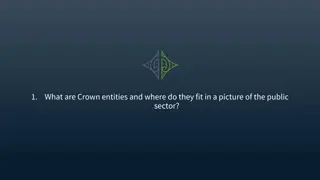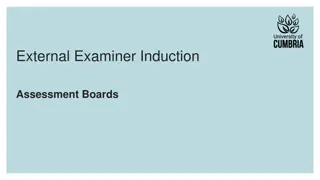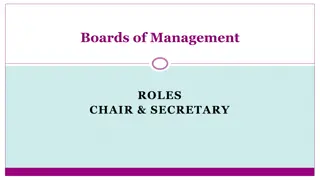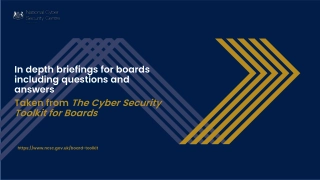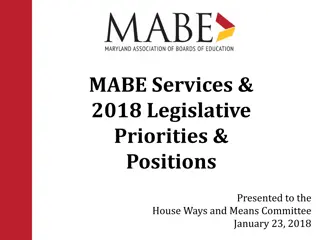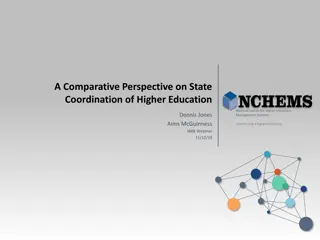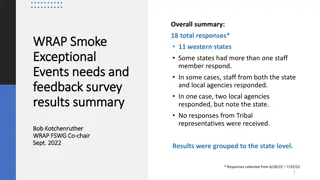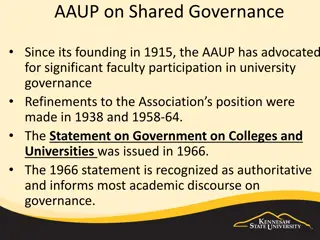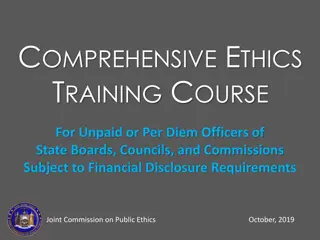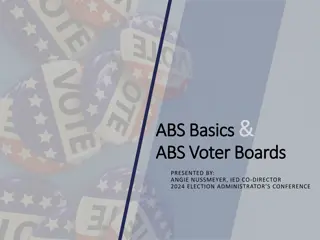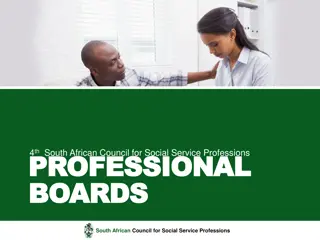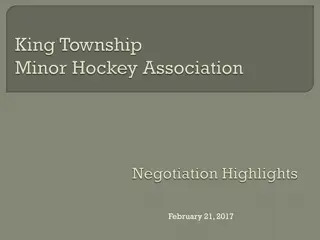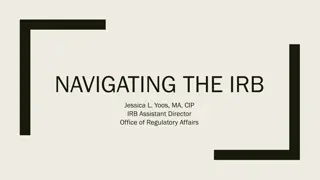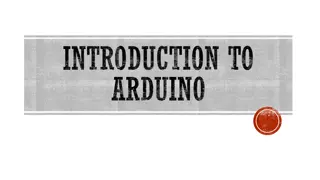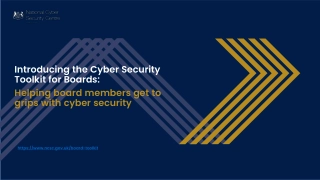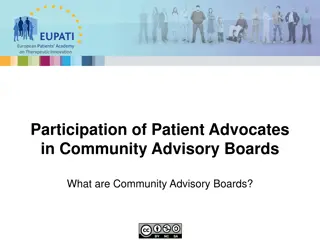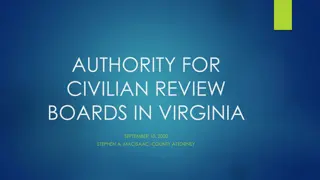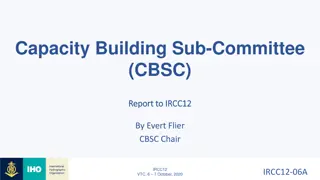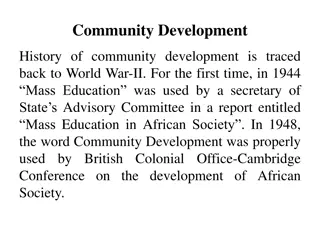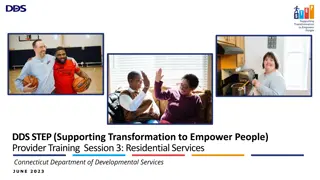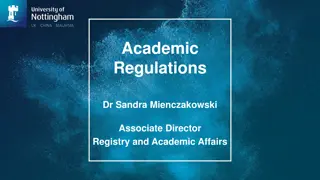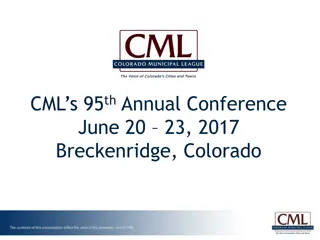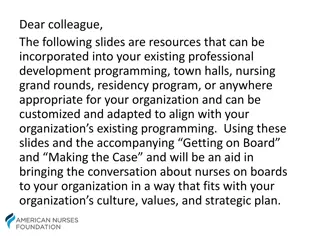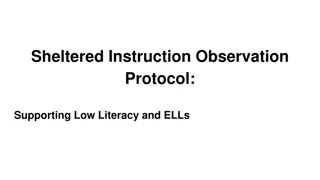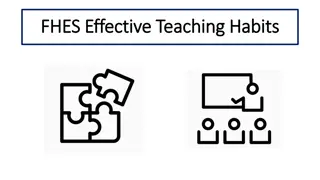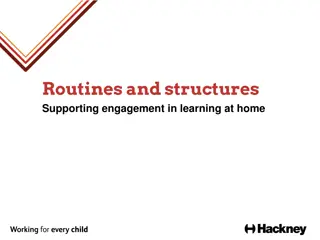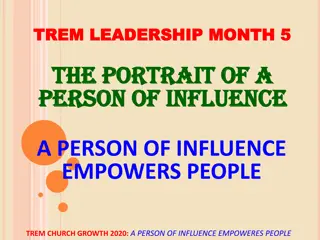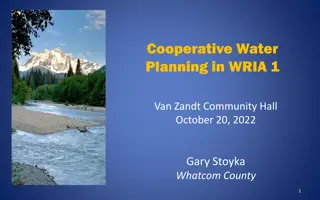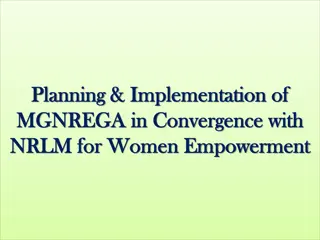Effective Strategies for Building and Empowering Exceptional Boards
Learn how to recruit and train high-performing boards, differentiate between responsible and exceptional boards, understand the different modes of governance, identify visionary board leadership traits, and implement an effective recruitment and training system for sustained success.
Download Presentation

Please find below an Image/Link to download the presentation.
The content on the website is provided AS IS for your information and personal use only. It may not be sold, licensed, or shared on other websites without obtaining consent from the author. Download presentation by click this link. If you encounter any issues during the download, it is possible that the publisher has removed the file from their server.
E N D
Presentation Transcript
Recruiting and Training a High Performing Board Abbie J. von Schlegell, CFRE a. a. von schlegell & co January 23, 2018 1
The Difference Between Responsible and Exceptional Boards BoardSource 2
Responsible Boards Capable and dutiful in carrying out its responsibilities Understands its fiduciary obligations Approves strategic plans and budgets Regularly reviews financial statements Evaluates the chief executive annually Participates in fundraising 3
Exceptional Boards Operate on a higher level -- more and different Members give more and differently: Time spent more wisely Skills, assets and social networks better leveraged and more strategically deployed. Measure organizational impact Evaluate their own performance Discuss and debate issues Engage in strategic and generative work Open doors and make strategic connections. 4
3 Modes of Governance Fiduciary Mode -- key questions "How are we doing to date?" Are we in compliance? Anything wrong? Strategic Mode -- key questions "What should we be doing? "Where are we going? What s the plan? Generative Mode -- key questions What are the new possibilities? What s coming next? What s the new question? 5
Visionary Board Leadership Visionary and future-focused Entrepreneurial spirit Risk-takers Strategic decision makers Effective communicators Systems thinkers Partnership and alliance builders Diverse 6
An Effective Recruitment and Training System Key Features and Characteristics 7
Key Features and Characteristics Formal ongoing board development process Process in place to identify and develop future leaders Rotation of committee assignments Board reflects full spectrum of constituencies Diverse in terms of critical demographic factors Continuing plan to maintain diversity Board size supports effective governance Comprehensive orientation for all new members All board members receive training 8
Markers of Effective Recruitment and Training The Governance Committee Board development as on-going leadership development Clearly defined roles and responsibilities Recruitment and training aligned with strategic plan Balancing diversity and commonality 9
The Governance Committee Leading the Effort 10
Board Governance Committee Continuous focus on identifying, preparing and recruiting future board leaders Plan board education including new member orientation, ongoing training and board retreats Assess board, chair, individual directors, and board meetings Annually review governance practices and recommend changes 11
A Leadership Development Process Nominations and recruitment -- identifying the right individuals to meet the needs of the board, helping them understand their roles and responsibilities, and inviting them to join your board Orientation -- giving new board directors information they need to carry out their roles and responsibilities effectively Training -- regular, ongoing efforts to build new skills and knowledge among the existing board directors to enhance performance 12
A Leadership Development Process Evaluation -- annual task of evaluating individual board director performance as well as the effectiveness of the board as a whole and individually Recognition -- ongoing process of recognizing the work and accomplishments of board directors to the work of the board and to the organization. 13
Clearly Defined Roles & Responsibilities 14
Clearly Defined Roles & Responsibilities Clarity re: management and governance Maintain clarity re: board policy and oversight functions Written individual board and committee descriptions that are current Board manual prepared for all board members 15
Board Member Job Description Attend all regular board meetings. Serve as an active committee member. Participate in fund development activities Support public policy agenda/initiatives. Prepare in advance for board policy and decision-making. Attend the annual board planning retreat. 16
Diversity in Recruitment Diversity in demographics Diversity in linkages to different communities and groups Diversity in expertise Diversity in thinking 17
Commonality in Recruitment In board members belief in the organization s mission and core values In board members depth of commitment In terms of focus on strategic work of the board 18
Recruitment Process Step 1. Establish a Board Governance Committee Step 2. Prepare for Active Board Director Recruitment Step 3. Develop a Profile of the Current Board Leading to Recruiting Priorities 20
Recruitment Process Step 4. Develop initial list of prospective Board members Step 5. First round of personal contact with top potential prospects Step 6. Scheduling and conducting orientation sessions with prospective Board members Step 7. Selection/Appointment of new members to the Board 21
Education/ Programs Fund Development Community/ Local Human Resources Communications Nonprofit Mgt. Year Group (s) Management Management Insurance or Information Investments Board Member Governance Collections Technology Marketing/ Retail Sales Museums/ Facilities Programs Business Finance History Govt. Legal 12 X X X X X X A. Smith 10 X X X B. Jones 11 X X X X X C. White X 11 X Other names, etc. 12 X X X X 10 X X X 10 X X X X X 11 X X X 10 X X X X 12 X X X X 11 X X X X X X 11 X 12 X X X X X X X X 10 X X Vacant 12 22
Where Do We Find New Board Members? The more specific the criteria, the easier to identify potential candidates. Think outside the box, approach professional organizations Look to people who have already shown an interest in the work of the organization Organize events that are designed to introduce the work of the organization Utilize board matching services 23
What Other Recruitment Tools and Techniques Have Worked for You? 25
Using a Blue Ribbon Nominating Task Force for Your Board A method to recruit 3 to 5 new Board Members in the next Six Months 26
Steps of the Blue Ribbon Process 1. Identify about 25 potential Blue Ribbon Committee members. 2. Invite them to participate on the Blue Ribbon Nominating Committee. Meeting once for one and a half hours Free breakfast or lunch 3. At the meeting . . . Brief update on organization s critical path Be clear on what you need board members to do Ask each member to nominate 3 to 5 prospects 27
Steps of the Process 4. After the meeting . . . Sift through the 10 = 20 nominations received Select the first names to call 5. Make the calls Emily, I m calling because Sally Carlson suggested you for our Board of Directors Face-to-face meetings with interested individuals 28
Building on the Results New board members ready to bring onto the board now or in the future Leadership contacts for committees, workgroups and special projects Deepened relationships with the connectors in your community Building a foundation for your board leader talent pipeline Convene new Blue Ribbon Nominating Committees when needed 29
Engaging New Members New members must be welcomed and oriented to its culture Provide each new board members with a clear roles and assignments Bring new board members into the board conversation Provide board mentors as option Check in periodically with new board members. 31
Board Orientation & Training Timetable During The Recruitment Stage (Before election or appointment) New Member Orientation (Immediately upon the election or appointment) Early Service (During the first three months of the new board directors tenure): Ongoing Training (Training and support on an ongoing basis for current and new board directors) 32
Orientation Purpose Three intertwining objectives: Inform new Board members about the organization and its programs Communicate performance expectations for board members Engage new members into the Board s work as quickly as possible 33
Topics for Orientation Programs and strategic direction Clients and constituencies Financial condition Structure of the Board of Directors Individual Board members responsibilities Board s relationship to the staff Personal interest in serving on the Board 34
Just-in-time Board Orientation An advance program of orientation and training to prepare prospective/new board members to hit the ground running Focus on the strategic plan Speed up the learning curve Increase confidence and productivity of new board members 35
Resources: A Starter List BoardSource www.boardsource.org Recruiting a Stronger Board: A BoardSource Toolkit Getting On Board With Effective Orientation: A BoardSource Toolkit Board Development Resources The Center for Public Skills Training www.createthefuture.com/past_articles.htm The Board-building Cycle, BoardSource The Source/12 Twelve Principles that Power Exceptional Boards, BoardSource 36
Thank you! 37
228 Main Street, Suite 272, Williamstown, MA 01267 410-908-9068 abbie@abbievonschlegell.com


